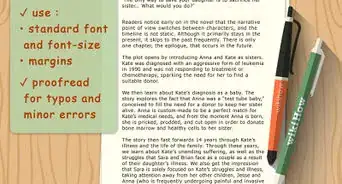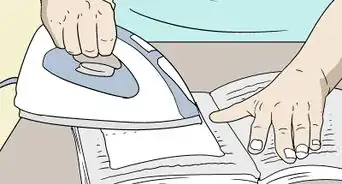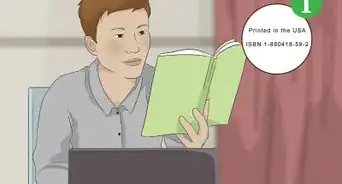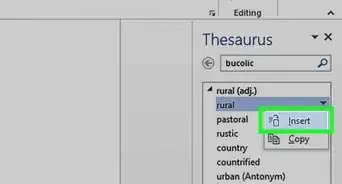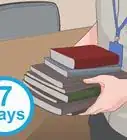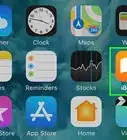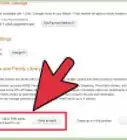X
This article was co-authored by wikiHow Staff. Our trained team of editors and researchers validate articles for accuracy and comprehensiveness. wikiHow's Content Management Team carefully monitors the work from our editorial staff to ensure that each article is backed by trusted research and meets our high quality standards.
This article has been viewed 45,514 times.
Learn more...
When a reader looks for a new author to read, they usually browse books in genres they enjoy. Whether you're describing your own work or shelving a book at a library, the right genre will help readers find what they seek.
Steps
Method 1
Method 1 of 2:
Marketing a Book with Genre Descriptions
-
1List possible genres for the work. Assuming the book is already complete, you can narrow it down to a subset of possible genres. List anything that could plausibly describe a part of the book, even if you think that "romance" or "action" are relatively minor components.
- If you're not trying to market a book, or you need help with genre definitions, skip down to the next section.
-
2Look up similar books online. If you don't feel confident about your list of possible genres, look up works you've read that are similar to the book you're marketing. If several of them are listed under the same genre, chances are your book will fit under that category as well.
- Conversely, if none of the books under "mystery" sound remotely similar to your book, it's probably a bad fit.
Advertisement -
3Track these genres on Amazon. Most fiction is sold through Amazon, so its top seller lists provide important information.[1] Although publishers conduct more complex analysis, anyone can conduct one test quickly:
- For each genre, compare the top seller lists each week for several weeks.
- If the same books stay in the top 10 for a long time, the genre is slow moving. This usually means there's less competition, but you'll be fighting for a smaller readership.
- If the list changes rapidly, that genre is fast moving. It will take more effort to compete, but the rewards (potential sales) are higher.
-
4Compare genre advertising fees. A roundabout but effective way to compare genre success is through advertising fees. Web pages such as BookBub advertising prices and Kindle Nation sponsorship tell you how much various sites value different genres. Genres with higher costs tend to have more competition, but larger readership for those who rise above the rest.
- BookBub's stats in particular give you excellent information if you plan to pay for advertising. Compare the cost of a featured deal and the effect of the deal (additional downloads/sales) to see which genre gives the best bang for your buck.
-
5Ask for input. You have some more information now, and may be able to narrow it down to a smaller list. Ask an editor, publisher, agent, or close friend for their input on the decision.
-
6Consider the target audience. Different genres have audiences with different demographics. Most readers will assume a romance novel is written for adults, while fantasy novels are more attractive to young adults. When you're deciding between genres, choose one with a main audience you think will enjoy the book.
- If your target audience is not the same as a typical book in your genre's, clarify with an additional description. For example, write "Young Adult Mystery" or "Literary Science Fiction."
-
7Choose two or three genres if reasonable. Most websites allow you to pick more than one genre to describe a book. It's often best to allow your book to compete in multiple genres or subgenres, such as "Science Fiction Horror" or "War Thriller."
Advertisement
Method 2
Method 2 of 2:
Understanding Genre Definitions
-
1Learn the main realist fiction genres. Genre is probably most important for fiction, as many readers use it to discover works they may enjoy. We'll start with realist fiction genres, or stories that are imaginary but theoretically possible:
- Crime has many overlapping subcategories, including mystery, suspense, and the action-oriented thrillers.
- Romance focuses primarily on a love story, and may or may not be erotic as well. This can stand alone or be combined with other genres, usually historical or paranormal fiction.
- Historical fiction can be set at any point in the past. Large libraries categorize it further by specific times and places. The Western is a popular subgenre with its own tropes.
- Action or adventure describe fast-paced tales of danger and exploration. It often includes elements from non-realistic fiction, but this isn't fundamental to the genre.
-
2Categorize speculative fiction. These stories could not happen in the real world in the present or past. The exact sub-categories are difficult to define, as there is a huge amount of overlap and experimentation. Here's how they're most commonly arranged, but don't be surprised if one book could fit into two or three of the following:[2]
- Science fiction tends to focus more on ideas than plot. It's often set in the future or in space, and attributes unusual phenomena to science (which may or may not be plausible).
- Fantasy includes magical or supernatural elements beyond the understanding of science. It tends to be plot-driven.
- Horror seeks to terrify the reader. While usually grouped in speculative fiction, there are examples of realist horror as well.
-
3Shelve nonfiction by subject. Any book that covers a topic in the real world is nonfiction, from chemistry textbooks to a collection of political speeches. You can refer to them just by describing the specific topic, or shelve them in a library with the Dewey Decimal System.[3]
- One popular nonfiction genre is the biography, which describes a historical figure's life. If written by the subject, call it an autobiography.
-
4Understand age descriptions. Many libraries and bookstores have "young adult" or "children" sections with no other labels. This isn't technically a genre, but it tells you the subject matter and writing is appealing and appropriate for that age group.[4]
- Coming of age novels describe the transition from childhood to adulthood. They're often aimed at young adults, but not always.
Advertisement
Community Q&A
-
QuestionHow do I find out the target age group of a book if it is not mentioned on the cover?
 Community AnswerYou can try searching for the title on WorldCat or Goodreads.This will show you how other readers have categorized the book, giving you a broad idea about the intended age group.
Community AnswerYou can try searching for the title on WorldCat or Goodreads.This will show you how other readers have categorized the book, giving you a broad idea about the intended age group. -
QuestionWhat book genre is The Maze Runner?
 Community AnswerThe Maze Runner is typically classified as young adult fiction, science fiction, and post-apocalyptic fiction (three genres). In a library, you'd probably find it in the young adult fiction section.
Community AnswerThe Maze Runner is typically classified as young adult fiction, science fiction, and post-apocalyptic fiction (three genres). In a library, you'd probably find it in the young adult fiction section. -
QuestionWhat genre is The Pearl?
 123wikihowlCommunity AnswerIt is a parable, which can be defined as a story that uses characters to teach a moral to its reader.
123wikihowlCommunity AnswerIt is a parable, which can be defined as a story that uses characters to teach a moral to its reader.
Advertisement
References
- ↑ https://www.amarketingexpert.com/amazon-categories-to-maximize-book-sales-a-little-known-secret/
- ↑ http://www.worldswithoutend.com/resources_sub-genres.asp
- ↑ https://lithub.com/theres-got-to-be-a-better-way-to-categorize-the-books-we-love/
- ↑ https://www.dummies.com/education/language-arts/getting-published/age-levels-for-childrens-books/
About This Article
Advertisement














